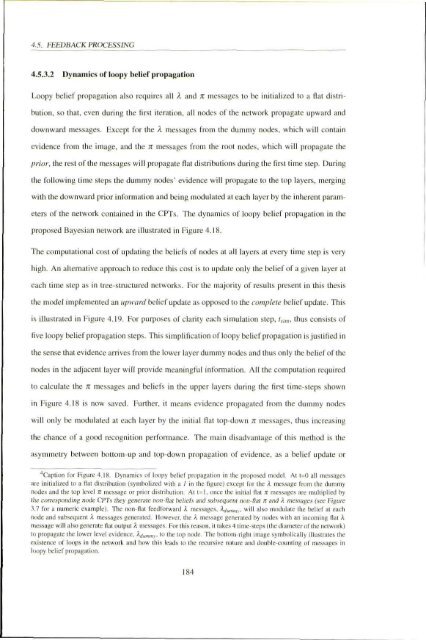Bernal S D_2010.pdf - University of Plymouth
Bernal S D_2010.pdf - University of Plymouth
Bernal S D_2010.pdf - University of Plymouth
You also want an ePaper? Increase the reach of your titles
YUMPU automatically turns print PDFs into web optimized ePapers that Google loves.
4.5. FEEDBACK PROCES.SING<br />
4.5.3.2 Dynamics <strong>of</strong> loopy belief pri>pa(>ulion<br />
Loopy belief propagation also requires all A and n messages to be initialized to a Hal disiri-<br />
huiion. so that, even during the lirst iteration, all nodes <strong>of</strong> the network propagate upward and<br />
downward messages. Except for the A me.ssage.s from the dummy nodes, which will contain<br />
evidence from the image, and the n messages from the root nodes, which will propagate ihe<br />
prior, the rest <strong>of</strong> Ihe messages will propagate Hal distributions during Ihe first time step. During<br />
the following lime sleps the dummy nodes' evidence will propagate to ihe top layers, merging<br />
with Ihe downward prior informalion and being modulated al each layer by the inherent param<br />
eters <strong>of</strong> the network contained in the CPTs, The dynamics <strong>of</strong> loopy belief propagation in ihe<br />
propo.sed Bayesian network are illuslraled in Figure 4.18.<br />
The computational cost <strong>of</strong> updating the beliefs <strong>of</strong> nodes at all layers at every lime step is very<br />
high. An altemaiive approach to reduce this cost is to update only ihe belief <strong>of</strong> a given layer al<br />
each time step as in tree-structured networks. For the majority <strong>of</strong> results present in this thesis<br />
the model implemented an Hpwnrrf belief update as opposed to the complelc belief update. This<br />
is illustrated in Figure 4.19. For purposes <strong>of</strong> clarity each simulation step, z,,,,,,, thus consists <strong>of</strong><br />
five loopy belief propagation steps. This simplification <strong>of</strong> loopy belief propagation is justified in<br />
the sense thai evidence arrives from the lower layer dummy nodes and thus only the belief <strong>of</strong> the<br />
nodes in ihe adjacen! layer will provide meaningful informalion. All the computation required<br />
to calculate the K messages and beliefs in the upper layers during the first time-steps shown<br />
in Figure 4.18 is now saved. Further, it means evidence propagated from the dummy nodes<br />
will only be modulated at each layer by the initial flat top-down K mes.sages, thus increasing<br />
the chance <strong>of</strong> a good recognition performance. The main disadvantage <strong>of</strong> this method is the<br />
asymmetry between bottom-up and top-down propagation <strong>of</strong> evidence, as a belief update or<br />
''Caption for Figure 4, |8, Dynamics <strong>of</strong> loopy bcliyt pnipagaiiun in ihc propo.sed nuxlel. Al 1=0 all messages<br />
are inilializcJ in a Hat diMribution (symbolized wiih a / in ihe figure) encepi for Ihe A message from the dummy<br />
nodes and the lup level Jr message or prior distrihuiion. Ai i^l, ouL-e the initial flat jz messages are multiplied by<br />
Ihe correiiponding node CtTs they generate non-flai beliefs and subsequent non-tlai JT and A messages (see Figure<br />
3.7 for a numeric example). The non-flat feedforward k messages, ^dumm\' *ill ^'so modulate Ihe belief at each<br />
node and subsequent A messages generated. However, the A message generated by nodes wiih an incoming flat A<br />
me.iisage will also generate Mat output A messagCfi, For this reason, il takes 4 time-steps (the diameter <strong>of</strong> the network)<br />
to propagate the lower level evidence, k^umn^. to ihe top node Tlie bottom right image symbolically illusirates the<br />
exisience <strong>of</strong> loops in the nelwork and how this leads to the recursive nature and doulile-counting <strong>of</strong> mes.sages in<br />
loopy belief propagation.<br />
184

















